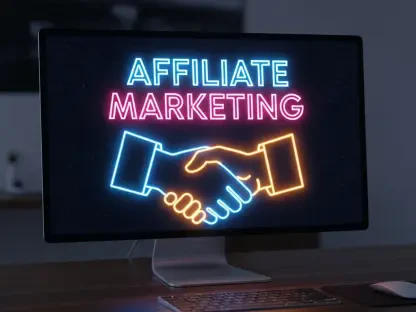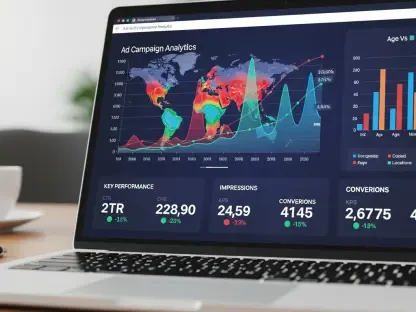As AI continues to transform the digital landscape, few are better positioned to guide us through these changes than Anastasia Braitsik, a global leader in SEO, content marketing, and data analytics. With her deep expertise in search engine marketing, Anastasia offers unparalleled insights into how artificial intelligence is reshaping the way we interact with search engines and advertising. In this engaging conversation, we dive into the evolving role of AI in search, the persistence of ads in this new era, innovative ad formats on the horizon, and the delicate balance between user experience and personalization. Join us as we explore the future of digital marketing through the lens of one of the industry’s brightest minds.
How do you envision AI transforming the way people search for information in the coming years?
I believe AI is going to fundamentally change search from a simple query-and-result model to a more conversational and intuitive experience. Users won’t just type in keywords; they’ll ask complex questions or even have ongoing dialogues with search engines. AI will anticipate needs, understand context, and deliver tailored results. It’s already happening with features like predictive text and personalized suggestions, but we’re just scratching the surface. Over time, search will feel more like a trusted advisor than a tool.
In what ways do you think user behavior will evolve as AI becomes more integrated into search platforms?
Users are likely to become more reliant on AI for decision-making. Instead of sifting through pages of results, they’ll expect instant, curated answers. We’re seeing a shift toward voice search and mobile-first interactions, where people want quick, hands-free solutions. There’s also a growing expectation for hyper-personalized content—users want results that match their preferences, location, and even mood. This means search engines will need to adapt to more nuanced, natural language inputs and deliver value in fewer clicks.
Why do you believe ads will continue to play a central role in the search experience, even with AI advancements?
Ads aren’t going anywhere because they’re a core part of the ecosystem that funds free search services. Beyond that, when done right, ads provide real value by connecting users with relevant products or services at the right moment. AI actually enhances this by making ads more targeted and less intrusive. The challenge is ensuring they don’t disrupt the user experience, but I’m confident that with smarter algorithms, ads can become a seamless part of the search journey, almost like personalized recommendations.
How can search engines balance the presence of ads with maintaining a high-quality user experience?
It’s all about relevance and timing. Ads need to feel like a natural extension of the search results, not a distraction. AI can help by analyzing user intent and only showing ads that align with what someone is looking for. Transparency is also key—users should know when something is sponsored, and they should always have control over their data. If ads solve a problem or answer a need, they’re less likely to feel intrusive. It’s a fine line, but with the right approach, it’s achievable.
Can you share some insights on how ads are being tested within AI-driven search environments?
Right now, a lot of experimentation is happening with integrating ads into AI-powered search features. Think of chat-style interfaces or voice responses where ads are woven into the conversation naturally. For example, if you’re asking about home improvement ideas, an AI might suggest a relevant service or product as part of the answer. These tests are focused on making ads feel helpful rather than forced, and early feedback suggests users are open to it when the content adds value. It’s still a work in progress, though, and there’s a lot to learn.
How do you think AI-driven recommendations can remain unbiased if they’re not influenced by ad data?
Keeping AI recommendations organic comes down to the data sources and algorithms behind them. If recommendations are based purely on web content, user behavior, and publicly available information—without factoring in paid placements—they can stay unbiased. It’s about building strict firewalls between ad systems and organic results. Search engines have to prioritize trust; if users feel recommendations are skewed by ads, they’ll lose faith. Rigorous testing and transparency in how these systems work are critical to maintaining that integrity.
What excites you most about the potential for new ad formats in AI search, and what might they look like?
I’m really excited about the creativity that AI opens up for ad formats. Imagine interactive ads where you can ask follow-up questions or get a virtual demo right in the search results. For something like shopping, ads could adapt in real-time based on your input—say, showing deals within a specific price range or for a particular style. These formats could be more visual or conversational, blending seamlessly with the search experience. The goal is to make ads feel less like interruptions and more like helpful tools.
How can ads become more useful to users by leveraging detailed input like preferences or specific constraints?
The more a search engine knows about a user’s needs—think budget, location, or even niche requirements like materials for a project—the better it can tailor ads. For instance, if someone’s looking for contractors and specifies they need eco-friendly options under $5,000, an ad can highlight a local business that fits the bill. AI can process this input instantly and match it with relevant offers. It’s about turning ads into solutions, not just promotions, by using that detailed context to create a personalized experience.
What steps do you think are crucial in the early stages of integrating ads into AI search systems?
First, it’s about testing and learning. We need to understand how users react to ads in these new environments and refine based on feedback. Prioritizing user experience over short-term revenue is key—ads shouldn’t break the flow of AI interactions. There’s also a need to develop guidelines for how ads appear, ensuring they’re clearly marked and relevant. Finally, investing in privacy measures is non-negotiable. As we collect more user data for personalization, protecting that information and giving users control is paramount.
What is your forecast for the future of ads in AI-driven search over the next few years?
I think we’ll see ads become almost indistinguishable from organic content in terms of relevance and helpfulness. Over the next few years, AI will refine ad delivery to the point where they’re hyper-contextual—perfectly timed and tailored to the user’s exact moment of need. We’ll also see more interactive and immersive formats, especially with the rise of augmented reality and voice search. The challenge will be maintaining trust and balance, but I’m optimistic that with the right focus on user value, ads in AI search will evolve into something users actually appreciate.









